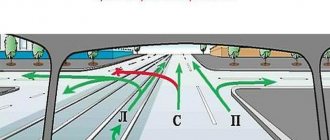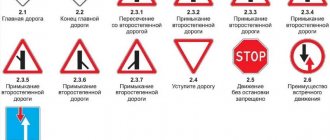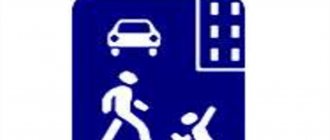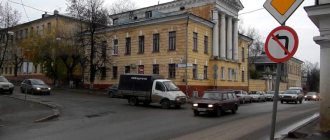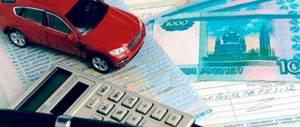I am studying at a driving school. I want to get my license. The process is not very easy. It is clear that you can memorize everything, but for safe driving you need to understand the essence of each rule. At the moment, one of the most difficult issues for me is turning around using the surrounding area. It is this rule that I decided to pay special attention to. After reading this article, you will learn:
- what is the surrounding area;
- how to make a U-turn according to the rules;
- penalties for violating the established rules.
U-turn at an intersection (controlled or unregulated)
One of the most difficult maneuvers. At first glance, this maneuver differs little from two consecutive left turns. The only problem is that the movement of drivers and pedestrians at the intersection is often very complicated, and you don’t very well understand who and how to let pass (according to traffic rules, and not “according to concepts”), which side to pass with cars making an oncoming maneuver. Plus, if the intersection is controlled, it is often not possible to make a U-turn in one traffic light cycle. Additionally, the situation can be complicated, for example, by the presence of pedestrian crossings (“zebra crossings”); hitting a “zebra crossing” (not necessarily with a wheel, a bumper or mirror is enough) can lead to failure of the exam. If there are such intersections in your exam area and you are asked to turn around at them, you need to practice turning at the intersection (do the maneuver several times). Always remember that at intersections it is unacceptable to “cut corners”; you always need to get into your lane. And keep in mind that the situation greatly depends on the car; the larger the car, the more difficult it is to carry out such a maneuver (for example, it is difficult to avoid hitting a zebra crossing).
A car for driving lessons and exams in the traffic police
Questions about the situation
Despite the fact that the courses cover turning around in nearby territory in sufficient detail, many drivers still have many questions. Here are examples of the most popular ones.
What is strictly prohibited to do in the adjacent territory?
Need to remember:
- Placing a car on the lawn is strictly prohibited. Failure to comply will result in a monetary fine.
- The same rule applies to trucks weighing more than 3.5 tons. They cannot be left near residential buildings.
- It is also considered a violation if a car with a running engine stands in a turning area for more than 5 minutes.
- A fine awaits the driver if he reaches a speed of 20 km or more.
Is parking allowed on site?
Parking can be done if there are special, marked places on the territory. Otherwise, the driver will also receive a warning and a fine if the situation repeats.
Light bulb spread
The most difficult version of a U-turn at an intersection is a “light bulb” U-turn. In this way, you have to turn around when, when trying to make a turn in the standard way, the car does not fit into the dimensions of the road. The peculiarity of the “light bulb” turn is that instead of taking the extreme left position on the lane and immediately turning, you have to first go to the right and only then start the turn (in this way the turning radius increases). How to make a U-turn at an intersection depends on the turning radius of a particular car - a compact car can make a U-turn in the standard way, but a large car can only make a “light bulb” turn.
Video demonstrating similar “light bulb” turns on the examination route of the State Traffic Safety Inspectorate:
You can read about the MREO, on whose examination route this video was recorded here:
Moscow MREO STSI Lobnenskaya - exam route, instructor for training on the exam route, reviews
Where can it not be performed?
Traffic regulations clearly limit the list of places and areas where turning around is generally prohibited.
These include (in parentheses it is indicated what the given territory is designated by: signs “z”, markings “r”):
- pedestrian crossings (z, r);
- tunnels (h);
- bridges, overpasses, as well as overpasses and areas under them. It’s worth going into more detail here. These sections of roads are not marked with signs, so you may not notice how, starting a turn from a regular road, it will continue along a bridge or overpass - you can accidentally drive over. This will be considered a traffic violation;
- at railway crossings (z + marking boundaries with barriers);
- on sections of roads where visibility does not reach one hundred meters. These areas are also not officially marked with signs, but you can navigate by the accompanying signs, such as those indicating descent and ascent, as well as curvature/curvature of the road;
- shuttle bus stops (w, r). If, during a turn, the car entered the pocket of the route stop, then it violated the traffic rules and it does not matter that this could have happened due to the insufficient width of the drive;
- places regulated by mandatory signs for driving in the forward direction, turning left, turning right, and prohibiting a U-turn;
- sections of roads delimited by a continuous marking line. It doesn’t matter - double or single - you can’t cross either one.
Although there are still motorists who do not comply with these restrictions and turn around at public transport stops, thereby creating an emergency situation.
Turning outside an intersection (“in one step”)
With complex maneuvers, it is very important to understand where they are possible and where they are not, so study the theory well - you will not have time to think for long. So, with a turn, a very common trick in the exam is to suggest turning around in places where there are all the conditions for a turn, except one, for example, there is no visibility for more than 100 meters (or while you are thinking about what to do, you arrive at such a place).
As a rule, it is impossible to turn around correctly within two lanes, so you need to look for a place with a small “pocket” on the opposite side. The role of a “pocket” can be an exit from the adjacent territory or some area next to the road.
When performing a maneuver, it is critical to turn around with a margin so as not to hit the curb. Moreover, keep in mind that at the slightest suspicion (not necessarily real), the inspector can hit the brakes and interrupt your maneuver.
Naturally, all maneuvers must be indicated with turn signals and all cars that have priority should be allowed to pass (wait for the moment when the car you are letting through will definitely not change speed or direction of movement).
Road and surrounding area
Before you make a U-turn using the surrounding area, you need to understand the basic concepts.
A road is a strip of land that is equipped and also intended for the movement of vehicles and people on it. A road can consist of one or several carriageways. There may also be dividers, curbs, sidewalks and tram tracks. That is, the concept is broad and general.
But the traffic rules do not define the adjacent territory (AT) as part of the road or carriageway. This is just a plot, an area adjacent to the road.
A characteristic feature of the PT is the impossibility of passing through it. You can go there, you can leave there. But only from one place.
PT is also determined by the following nuances:
- vehicles may be in this area outside the traffic flow without violating traffic rules;
- behind the entrance to the PT there may be a gas station, service station, cafe, residential buildings and other structures;
- Here you can safely stop and park;
- The PT is located right next to the roadway, but at the same time is located in isolation from the traffic flow.
A driver planning to make a safe U-turn using the adjacent area, or to park temporarily there, should be aware that they do not receive any priority.
It's rather the opposite here. First you need to yield to cyclists and pedestrians. Driving at a speed of more than 20 km/h in the PT zone is prohibited. Otherwise, a fine will be issued.
Turning around using the local area (“in two steps”)
If it is not possible to turn around in “one step,” you will have to turn around in two steps, with reverse gear engaged. The action is very similar to the “boxing drive” exercise. The only problem is that you need to control passing cars and not interfere with them. You must practice confidently doing this maneuver; finding a place to practice is not difficult. Again, do not forget about turn signals and hazard lights when moving backwards (according to traffic regulations, in this case you need to use turn signals, but in many MREOs it is customary to use emergency lights, it makes sense to clarify this issue (local specifics)).
Links to useful materials:
Driving in the city, task setting
Where to study (driving school training route)
Basic driving skills (basic road maneuvers)
Difficult vehicle maneuvering (maneuvers on roads that require special training)
Turn right - what the traffic rules say and what the real situation on the roads is (how drivers with driver’s licenses usually act)
Right turn - how to act during the exam and what the inspector will pay attention to
Registration for exams and retaking exams at the traffic police in a driving school
Registration at the traffic police for the exam and retaking the exam to obtain a driver's license
Alternative options for registering for the exam at the State Traffic Safety Inspectorate (via the State Services website or in person at the REO), how to speed up the exam
Procedure for passing the traffic police exam driving in the city
The traffic police examination route, the road conditions on the route and the features of the maneuvers that will have to be done during the traffic police exam
Published 17.2.2016, version 1.2 from 20.07.2018
Author: Alexander Rulim (Sasha Rulim)
Passing in courtyards
UAZ loaf axle shaft Pages Recent entries Categories Recent comments
Driving in courtyards can be not only oncoming, but also passing. In this case, you have to go around cars stopped directly on the road. As a rule, such stops are made by drivers to pick up or unload passengers or briefly unload cargo. In such situations, it is better to wait until the driver of the vehicle stopped in front finishes his business and continues driving.
In cases where the stopping of the front vehicle is associated with its malfunction or prolonged activity (the work of firefighters, emergency medical services, police, utility services), you should not show aggression and try to drive the driver from his place. He stopped for a reason, and it will hardly be possible to drive away from the required place. It is much easier to reverse to a place where a U-turn is possible, drive out and enter the yard on the other side. This will avoid problems with oncoming traffic. The road is blocked by a service vehicle, which means no one will move towards you.
It should be remembered that all unofficial rules for traveling are based on the principles of mutual respect and care for others. Conflicts on the road rarely achieve the desired result. As a rule, they lead exclusively to loss of time, and sometimes health. Therefore, communication with other drivers and joint decision-making on the optimal driving route should be carried out in a friendly atmosphere, without insults or assault. Unfortunately, many modern drivers neglect this obvious rule, which often has very negative consequences for both parties to the conflict.
Read: 4,782
Support Rulims!
If Rulims helped you (simplified the process of obtaining a driver’s license or allowed you to save money in something else, for example, in choosing some devices or receiving some services), help him too, I will be grateful for any amounts, you can transfer either from a bank card or and from Yandex.Money (you must select the desired payment method). The funds received will allow us to develop the resource, raise new topics and possibly offer new services.
If you cannot use the proposed translation methods, please support the Charitable Foundation Tradition, which is close to me. They have access to almost all available methods of receiving funds.
You can also help by publishing a link to Rulims (https://www.rulims.ru) on your favorite social network, blog or forum (I would be especially grateful for blogs and forums, thank you very much in advance). I will also be grateful for participation in groups on social networks and extremely grateful for reposting materials of interest to you on your blogs and forums. Your comments and examples from your experience are also very useful for the development of the project. To comment, it is better to register on Rulims. The registration form on the site is as simple as possible; services are provided only for registered users. You can read more about how you can help the resource on the Support and participation in the project page.

